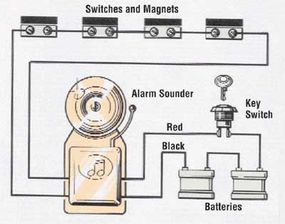Some home security systems are complex and should be installed by a professional. However, there are many good home security systems sold in kit forms that can be installed by any do-it-yourselfer. Most simple systems use a bell, loud buzzer, or other sound source to note intrusion.
Installation involves mounting the sound source or sounder in a location where it can be easily heard. Then attach a circuit of switches to the sounder and connect a battery to the system. Since the sounder operates from the battery, it remains an effective alarm system even in the event of a power failure. Alternately, battery-operated remote wireless sensors and controls can be installed. However, make sure that batteries are replaced regularly.
Advertisement
In electrical terminology, this alarm system is called a closed-circuit system. When the doors and windows are shut, the attached switches are closed. Because all the switches are in a wiring loop, opening any one of them breaks the loop and triggers the sounder circuit. Simply closing the door or window, moreover, does not restore the switch loop circuit continuity and does not stop the sound until either the battery becomes exhausted or someone switches off the circuit from battery to sounder.
There is an electronic switch built into the sounder. This switch is turned on by breaking the magnetic-switch loop. A key-operated switch in the sounder circuit allows you to turn the alarm system completely off when it is not needed. Also, once the alarm goes on, operating the key switch is the only way to silence the sounder. Only someone who has a key to the switch can reset the system.
The switch device consists of two parts that look much alike: one small plastic box that contains a strong magnet, and another that contains the actual switch. When magnet and switch are not near each other, the switch contacts are separated and the switch is open. On the other hand, when the magnet and switch are near each other, the switch contacts move together and the switch closes. The magnet part of the device is screwed to a door or window, and the switch part is screwed to the door or window frame. Thus, opening a door or window separates magnet from switch, causing the switch to open and trigger the alarm.

The three electronic parts that comprise the solid-state switch of the alarm sounder are mounted on a circuit board. Under the circuit board are a solenoid coil and a plunger that strikes the bell or activates the electronic sounder. Below the coil is a set of breaker points that causes the plunger to vibrate up and down, activating the sound source.
Installing the Components
Install the sounder first. Decide where you want it located -- either to attract the most attention for help or to scare away an intruder. If you decide to mount the sounder outdoors, you must drill a hole through the wall for the wires. To shield the sounder from the weather, you should install it in a protective metal box of the type made especially for alarm sounders. Inside the box is a bracket for mounting a tamper switch that sets off the alarm system if someone tries to open the alarm sounder box. Located in the side of the box is the key switch that allows a person with a key (but no one else) to activate, service, reset, or deactivate the alarm system.
If you want the sounder to be located indoors, you need not install it in a protective metal box. Mount the sounder on the wall in a place where it can be heard easily. Placing an indoor sounder in a closet or other confined space is not recommended.
The kit should include a mounting backplate attached to the sounder by a mounting screw. Remove the nut and separate the backplate from the sounder. You will see a pattern of holes in the backplate. Using wood screws, toggle bolts, or other suitable fasteners, attach the plate to the wall at the place you have chosen to position the sounder. Mount the backplate with enough fasteners to hold the sounder solidly in place. Make sure that the plate is mounted right side up, and that the correct side is forward. There is usually a tongue on the backplate that should be at the top when it is mounted properly. Do not connect the sounder to the backplate until later. You will find that the protective box for an outdoor installation already contains a built-in backplate. Mount the box in the desired location.
Next, install the door and window switches. The magnet part goes on the door or window, while the switch part goes on the window frame or doorjamb. Use the mounting screws in the kit to attach the parts. Try to position the two parts of the switch so that they are close together -- almost touching -- when the window or door is closed, and widely separated when the door or window starts to open.
If you wish, you can include fire sensor switches in the loop of entry-detection switches. Use the kind of fire sensor switch that breaks the loop when the air temperature in its vicinity reaches 135 degrees Farenheit.
Since that is more than the air temperature is ever likely to reach normally -- except in attics, furnace rooms, or over wood or coal stoves or other high-heat producers -- you will never experience false alarms during hot weather. Install 190 degrees Farenheit sensors in normally hot locations. You should mount the fire sensor switches in the spots where you feel they will be most effective. There is no reason why you cannot put one or more sensor in every room that is being wired for the security system.
Consider using current-conducting window foil tape for additional security. Silver foil with a self-adhesive backing is probably available where you purchase your alarm system. It is designed to trigger the alarm if an intruder breaks the glass in a door or a window. During installation, make sure there are no breaks in the foil that you stick on the glass; the tape must be continuous. Self-adhesive foil terminals or connectors at the ends of the foil tapes let you connect the loop circuit wiring, and a flexible door cord allows you to open a foil-taped door or window without setting off the alarm system.
In the next section, let's consider how to wire all of these components together.
Advertisement

